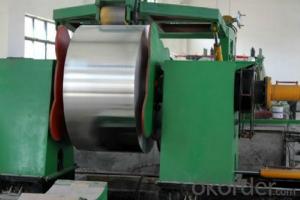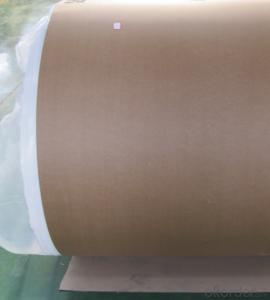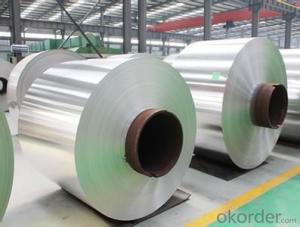Aluminum Corrugated Plastic Sheets 5052 H32 Aluminum Gutter Coil
- Loading Port:
- Shanghai
- Payment Terms:
- TT OR LC
- Min Order Qty:
- 5 m.t.
- Supply Capability:
- 9000 m.t./month
OKorder Service Pledge
OKorder Financial Service
You Might Also Like
Specification
| Product | Aluminum sheet |
| Country of Origin | China mainland |
| Alloy | 7075 |
| Temper | T6 |
| Width | 200-1500mm |
| Thinkness | 6-100mm |
| Length | less than 8000mm |
| MOQ | according to different size,normal 5 tons |
| Payment Terms | T/T;L/C |
| Loading Port | DaLian,Tianjing,Shanghai |
| Delivery Time | Within 30 days after receiving the prepayment or original L/C |

1.Tolerance: thickness tolerance +/-1.5%, width tolerance +/-1mm
2.Application and Usage:
Building Material , Insulation, Shoes &Tents Eyes,Corner Beads,Automotive Industrial, POP Can Bottle and Cap,Deep-Proceeding Case,light industry, TV back board,Street Sign, PP caps, Cell mask and so on.
3.Surfact Quality :
Be free from Oil Stain, Dent, Inclusion, Scratches, Stain, Oxide Dicoloration, Breaks, Corrosion, Roll Marks, Dirt Streaks and other defect which will interfere with use,
4.Mechenical Property:
Chemical Composite and Mechanical Property could meet the requirements of GB/T, ASTM, ENAW, JIS Standard

5.Packing:
a, Vertical packing
b, Horizontal packing
c, First, plastic cloth with drying agent inside; Second, Pearl Wool ; Third, wooden cases with dry agent , fumigation wooden pallets, aluminum surface could cover blue PVC film
6.Certificate: ISO9001:2008, SGS and ROHS(if client request, paid by client), MTC(plant provided), Certificate of Origin(FORM A, FORM E, CO), Bureau Veritas and SGS (if client request, paid by client), CIQS certificate
7.Month Capacity: 20000MT/Month
8.Trade Terms: EXW,FOB,CIF,CNF
9.Payment: T/T or L/C at sight

- Q: what's the oxidation method of positive pole on the surface of aluminum sheet?
- Do chemical polishing again, oxidation time is about 40 – 90 minutes, after finishing all of these, you can conduct positive pole oxidation, choose sulfuric acid solution in normal situation, pretreatment is very important in the whole process, take stereo as negative pole, firstly, use the solution mixed of carbonate-bicarbonate and detergent to heat and clean its surface, pretreat the aluminum sheet, dyeing according to requirement after oxidation, then remove the oxide film with oxide film removal solution, place aluminum sheet on the positive pole, finally closing it in the boiling water for about 15 minutes.
- Q: i want to a material which is similar in properties like aluminium which has similar casting properties and easily available.
- Aluminum is lousy for casting because it shrinks and tears. However you can add about 2% finely divided steel and get a useable alloy. It is better to use what everybody else uses: pot metal. Any junk yard can provide an endless supply of carburetor bodies which you can melt at fairly low temperatures and get nice strong castings. If you can locate some ancient floppy drives or dot matrix printers you will get a prettier alloy.
- Q: What's the maximum size of 3 mm thick aluminum sheet?
- First look at tolerance taggingIf there is no tolerance, see the accuracy level of the workpiece and check the tolerance listA 3-4 mm deviation is acceptable if the magnitude is not noted and is of no importanceThat is, the 34mm can also be used if lower precision sizes can be addedOnly board class is generally down bias, there is very little difference
- Q: Can aluminum sheets be an alternative to stainless steel?
- In certain applications, aluminum sheets can serve as a viable substitute for stainless steel. Aluminum, a lightweight metal, exhibits a favorable strength-to-weight ratio, making it suitable for various industries including aerospace, automotive, and construction. Similar to stainless steel, aluminum boasts a high level of corrosion resistance due to the formation of a protective oxide layer on its surface. When it comes to cost-effectiveness, aluminum sheets can prove advantageous over stainless steel, particularly in large-scale projects where reduced weight can lead to lower transportation and installation expenses. Furthermore, aluminum possesses excellent thermal and electrical conductivity, making it an appropriate choice for applications requiring such properties. Despite these advantages, stainless steel still outshines aluminum in certain aspects. Generally, stainless steel is stronger and more durable, rendering it suitable for heavy-duty applications or environments that demand high mechanical strength. Moreover, stainless steel exhibits superior resistance to extreme temperatures and fire, which can be critical in specific applications. In conclusion, while aluminum sheets can serve as an alternative to stainless steel in many scenarios, the ultimate selection hinges upon the specific requirements of the application, encompassing factors such as strength, durability, corrosion resistance, and cost.
- Q: I'm about to fix the aluminum wiring in my house using Alumiconn connection, so I know that every outlet and switch plate need to be done, do the light fixtures need to be done as well? And also does anything need to be done with the main circuit breaker?
- I never understood why aluminum wire was ever used, it is inherently unsafe. I would replace the whole thing with copper.
- Q: Can the export quality of China's aluminum plate meet the requirement of ASTM B 209? Is this requirement for our country? Master the exhibitions, O (a _ U) O thank you
- ASTM is the standard used in the United StatesEquivalent to China's GBGenerally equivalent to the use of Chinese standardsSpecific depends on whether the customer agreesIn fact, just do a testMeet its requirements
- Q: Are the aluminum sheets suitable for manufacturing aircraft interiors?
- Yes, aluminum sheets are highly suitable for manufacturing aircraft interiors. Aluminum is a lightweight and durable material that offers excellent strength-to-weight ratio, making it ideal for aviation applications. It is resistant to corrosion, easy to fabricate, and can be easily formed into various shapes and sizes required for aircraft interiors. Additionally, aluminum sheets can be treated with coatings or finishes to meet specific design and functional requirements.
- Q: Can aluminum sheets be used for solar panel applications?
- Yes, aluminum sheets can be used for solar panel applications. Aluminum is a popular choice for solar panel frames and mounting systems due to its lightweight, strength, and corrosion resistance properties. It is also easily recyclable, making it an environmentally friendly option. Aluminum sheets provide structural support and stability to solar panels, ensuring they can withstand various weather conditions and last for a long time. Additionally, aluminum's high thermal conductivity helps dissipate heat generated by the solar panels, improving their overall performance and efficiency.
- Q: What are the methods to protect aluminum sheets from corrosion during their usage?
- <p>To prevent corrosion of aluminum sheets during use, several strategies can be employed. First, apply a protective coating such as paint, anodizing, or a conversion coating to create a barrier against corrosive elements. Second, ensure proper cleaning and drying to avoid the accumulation of moisture and contaminants. Third, use corrosion inhibitors in environments where aluminum is exposed to aggressive chemicals. Fourth, maintain good ventilation to reduce humidity levels. Finally, regularly inspect and maintain the aluminum sheets to address any signs of corrosion early. These measures can significantly extend the lifespan and performance of aluminum sheets.</p>
- Q: What are the common surface treatments for aluminum sheets used in outdoor applications?
- The common surface treatments for aluminum sheets used in outdoor applications include anodizing, powder coating, and PVDF coating.
Send your message to us
Aluminum Corrugated Plastic Sheets 5052 H32 Aluminum Gutter Coil
- Loading Port:
- Shanghai
- Payment Terms:
- TT OR LC
- Min Order Qty:
- 5 m.t.
- Supply Capability:
- 9000 m.t./month
OKorder Service Pledge
OKorder Financial Service
Similar products
Hot products
Hot Searches
Related keywords



























